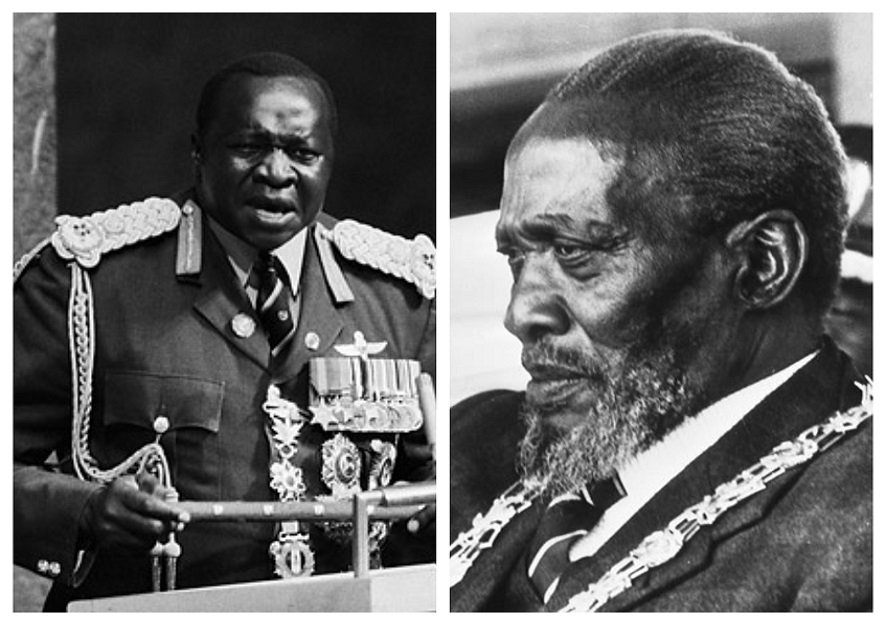When Uganda’s former leader, Idi Amin, seized power from the then president, Milton Obote in 1971, his act was received with lots of cheers in Kampala but he would later be seen as a monster after he took up a dictatorial style of leadership.
He had come to power with good intentions for his people but as time went on he became power-drunk and started abusing people, historians say.
He became ruthless and brutal, repressing the Ugandan people and ignoring their human rights, and subsequently ruined the economy when in 1972, he ordered the deportation of over 80,000 Asians living in Uganda.

Amin in 1972 sacked over 80,000 Asians living in Uganda
Western leaders, including the United States, cut ties with Amin, and this, coupled with the growing resentment he was getting from his country made him believe that waging war against neighbouring Kenya would save his regime.
In 1976, the military dictator attempted to redraw the boundaries of Uganda and Kenya saying that he wanted back all Kenyan districts that were part of Uganda before the colonial re-demarcation of the territorial boundaries.

When part of eastern Uganda was transferred to Kenya — Daily Monitor
These included Turkana, part of Lake Rudolf (now Lake Turkana), West Pokot, Trans-Nzoia, Bungoma, Busia, Kakamega, Central Nyanza, South Nyanza, Narok, Kisii, Kericho, Nakuru, Uasin Gishu, Elgeyo, Marakwet, Nyandarua, Nandi, Kisumu, Eldoret, Tambach, Maji Moto, Maji Mazuri, Gilgil, Nakuru, Lake Baringo and Naivasha.
Amin further claimed part of the current Republic of South Sudan up to Torit, as he stressed that the area belonged to Uganda prior to the Berlin Conference of 1884 that demarcated Africa among European powers.
He further argued that British colonialists “made several mistakes when they were making territorial demarcations because all ethnic groups had blood relations across borders”.
In Amin’s words, “God was not a fool” to have given these fertile districts to Uganda and vowed to fight to get them back.

Jomo Kenyatta — Zipo.co.ke
This angered the Kenyan administration then headed by Jomo Kenyatta, who would subsequently deploy the military and tanks along the Kenya–Uganda border where they were met by large crowds in Kenyan town, Malaba where Amin’s effigy was burned.
“The government in Nairobi already had frosty relations with Amin.
“There had been the issue of displacement of Kenyans and the disappearance of freedom fighter and politician Kung’u Karumba in Kampala. The threat to wage war was seen as the last straw,” according to veteran Kenyan journalist and author Joseph Karimi.
Before sending the troops to secure his borders, Kenyatta rallied his people together in support of the military when he gave a powerful speech that reportedly had echoes of Sir Winston Churchill’s speeches when Britain faced an invasion from Adolf Hitler’s army.
“There are people that are envious of our independence and sovereignty. But whoever they are, black or white, I warn them that I am warlike, and we will not tolerate anyone playing about with our sovereignty. I wish to warn those who may have designs on Kenya that even if they have guns and warships we shall deal with them ruthlessly,” said Kenyatta during a massive rally at Uhuru Park.

Kenyan military — capitalfm.co.ke
“Our obligation and commitment is to defend our independence and borders day and night. We are not interested in provoking anyone, but those who want to play about with Kenya must know that they will be dealt with ruthlessly. Kenya has no claims over anybody’s territory. We welcome good neighbourliness and cooperation. We shall, however, never entertain or tolerate anybody laying claims over our country, be they friend or a foe,” he was quoted by Kenyan media Daily Nation.
“Those who say their country extends from present borders, I advise them to go to hell and dream there. We shall have no one lay claims over our territory. We shall not give away an inch, not even a quarter of an inch! Our forces are ready and wananchi will use spears, simis, arrows, rungus or even blows and kicks to repel any threat,” Kenyatta warned.
That wasn’t all as Kenyatta ordered the closure of the border which led to shortages of fuel and other commodities in Uganda’s capital Kampala.
The Kenyan government further called on the OAU and other regional players into urging Amin (who was then the chairman of OAU) to back down. Besides, in 1964, the now-defunct organisation had passed a resolution that all member states should respect the borders existing on their attainment of independence.

Former Uganda’s President Idi Amin Dada chairs the 12th Organization of African Unity (OAU — The East African
A committee of the heads of state of Ethiopia, Zaire (present-day Democratic Republic of Congo), Burundi, Rwanda and Zambia was also formed to look into the issue, according to Kenyan media, though, by that time, Amin had backed down on his invasion plans.
He would in three years be toppled by rebels in exile backed by Tanzanian forces as they seized control of Uganda. The once-feared ruler had to seek refuge in Saudi Arabia where he lived until his death on August 16, 2003, at the age of 78.










